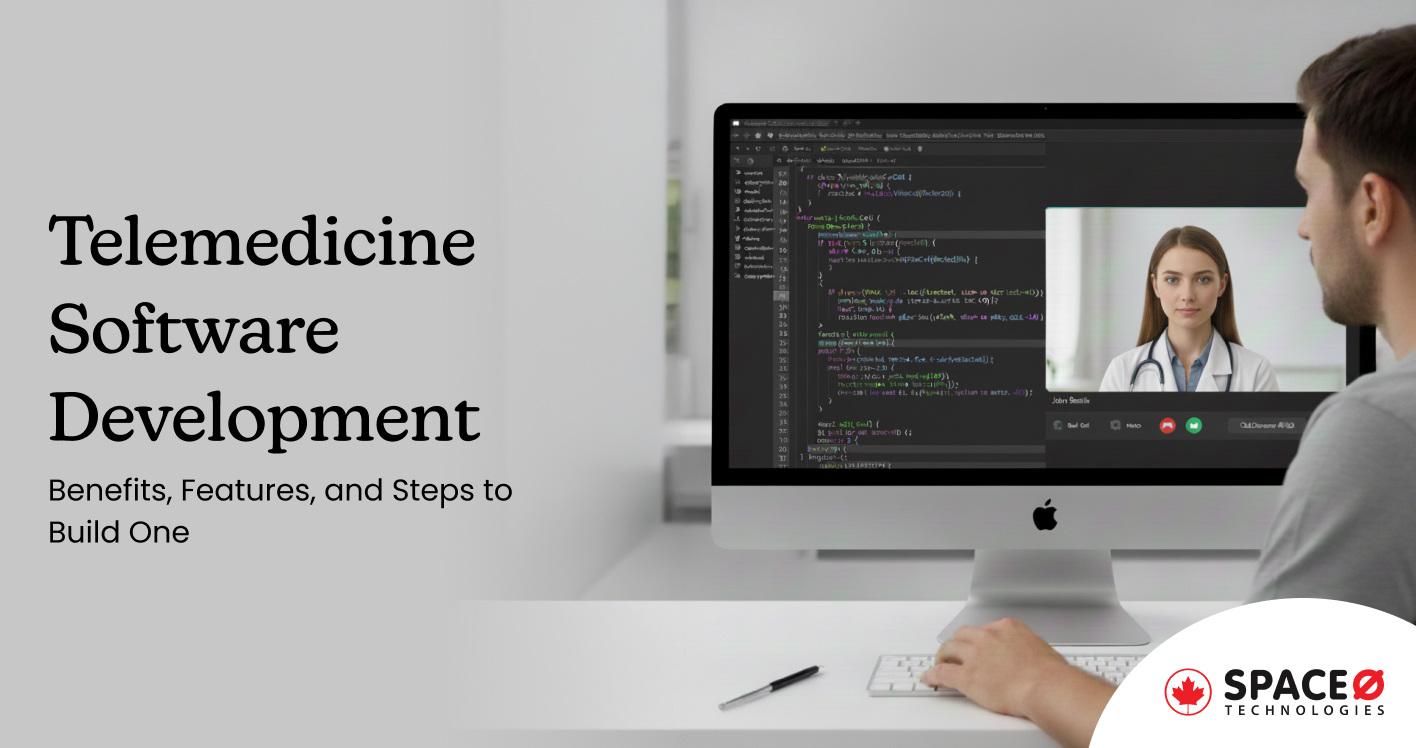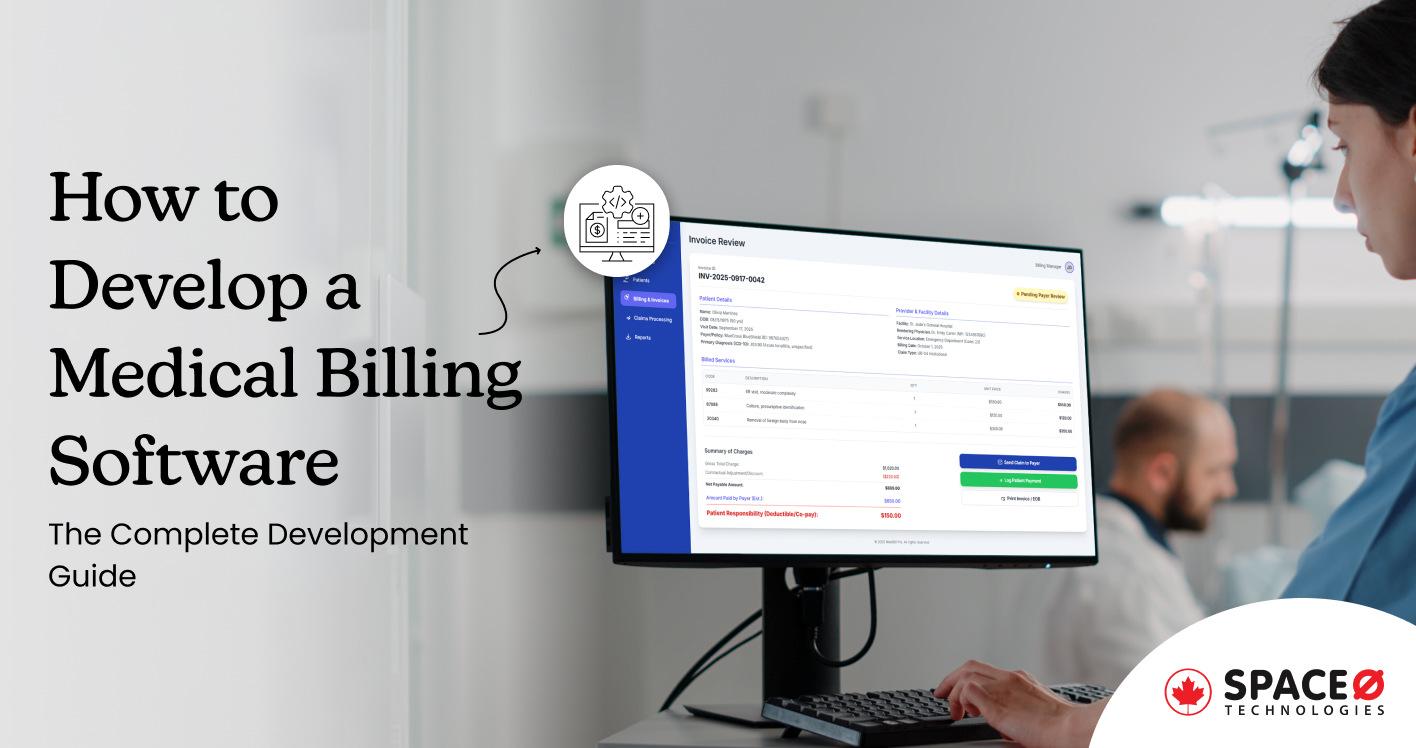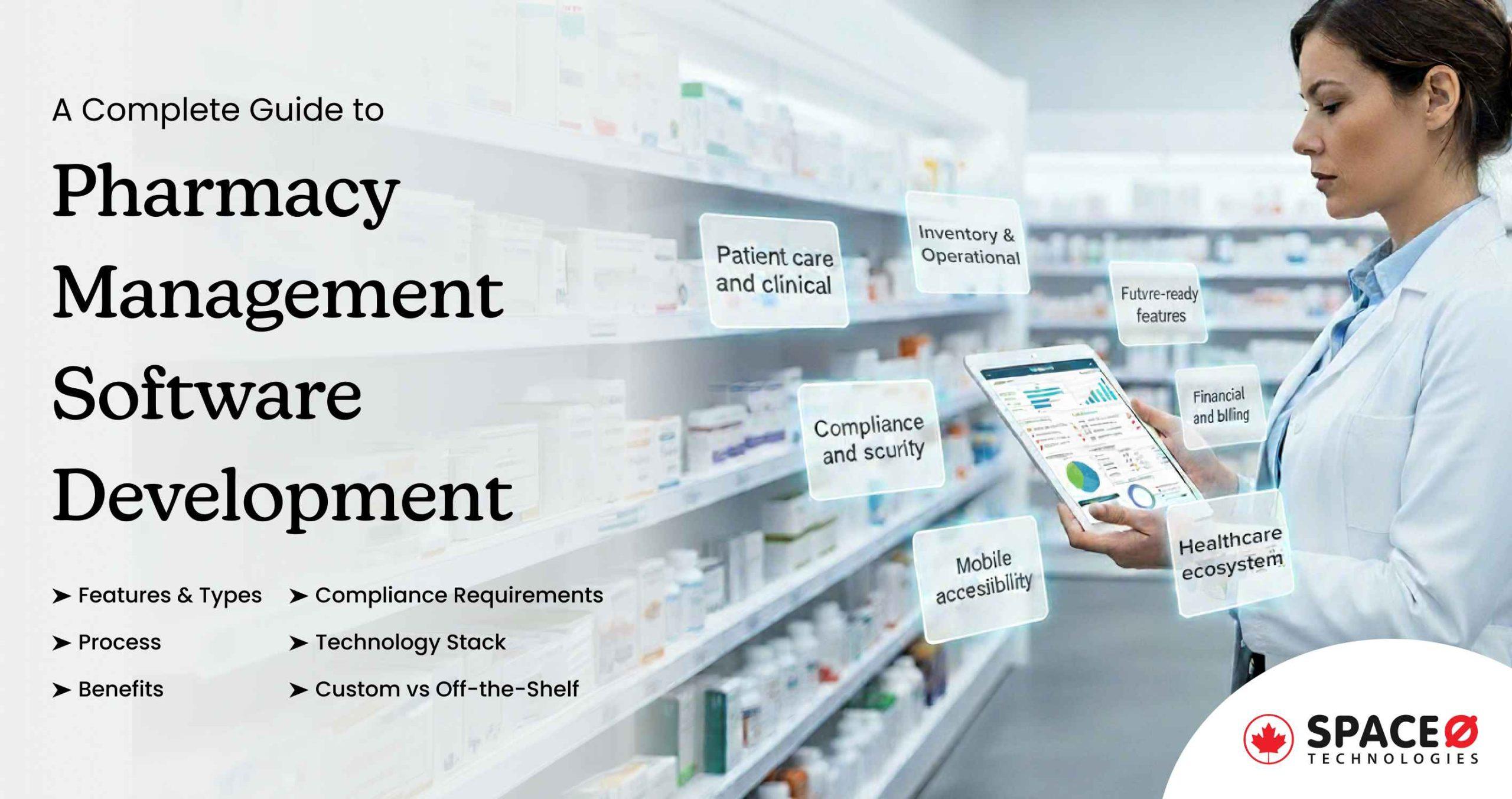
The Ultimate Guide to Software Product Development
If you are looking to optimize your business operations? Your search ends here. The perfect solution to your question is to develop a software product.
However, creating a software product is not simple, it involves technical challenges, market research, and competitive analysis. As a leading custom software development agency, we have written this detailed blog post to guide you through this software development process.
You will be learning the following topics in the blog post.
- Step-by-step software product development process
- Benefits & drawbacks of software product development
- Types of development methodologies
Understanding each of the above topics will help you know better about software product development and make informed decisions. So let’s discuss each in detail.
Table of Contents
What is Software Product Development?
Software product development refers to the process of conceptualizing, designing, developing, testing, implementing, and sustaining software products. This includes all phases of the software product development cycle from coming up with the idea to ongoing maintenance and further technical improvements of the software product.
The steps used to make software are organized into a plan called SDLC (Software Development Life Cycle). The software development lifecycle covers the steps and activities involved in the development of software, which include:
- Planning: Defining project objectives, timelines, and resource requirements.
- Design: Creating the software’s structure, including interfaces and functionality.
- Coding: Writing the actual code for the software.
- Testing: Rigorously examining the software for issues and bugs.
- Deployment: Making the software available to users.
- Maintenance: Ongoing activities to keep the software functional and secure.
SDLC strategies, such as Agile, Waterfall, or DevOps, give systematic ways to manage and control software projects. You might be wondering is software development similar to software product development? Let’s check out the next section to help you know the software product development process.
How Software Product Development is Different From Software Development?
Software development is like creating custom tools or solutions for a specific job. It involves activities such as identifying requirements, designing, coding, testing, and ensuring ongoing smooth operation.
Software product development, on the other hand, revolves around creating software with mass appeal, similar to the apps you find on your phone. This process involves assessing user needs, analyzing the competitive landscape, strategizing for the software’s future, and assembling a dedicated team for its development.
| Aspect | Software Development | Software Product Development |
|---|---|---|
| Scope | Creates software apps or systems for specific needs or projects. | Focuses on crafting software products for broader market distribution. |
| Key Activities | Includes requirements, design, coding, testing, debugging, and maintenance. | Involves market research, competitive analysis, feature prioritization, and planning. |
| Characteristics | Adaptable solutions for diverse goals. | Products designed for wider adoption, managed by dedicated teams. |
| Key Focus | Addresses specific project needs. | Aims for broader market reach with strategic planning. |
So, there is a small but important difference between software development and software product development. Software development is about making custom solutions for specific needs, while software product development is about creating software for a wider audience. Now, let’s take a closer look at the software development process to better understand how it works.
Software Product Development Process in 5 Easy Steps
Here are the 5 easy steps involved in the software product development process.
Define Your Idea and Conduct Initial Market Research
In the initial phase of software product development, you need to clearly define the problem your software will be solving. This could range from streamlining business processes to enhancing user experience in a specific domain.
For instance, if you are aiming to develop a project management tool similar to Trello or Asana, your focus will be on solving issues like task tracking inefficiency or communication barriers in teams.
This step is about setting a clear goal for your software. Let’s help you understand it better by taking an example of a project management tool like Trello or Asana. Here’s how you would proceed:
- Conduct a comprehensive analysis of prevalent project management software like Trello and Asana, highlighting their strengths and weaknesses.
- Engage in direct discussions with small business stakeholders to uncover their unique requirements, such as task prioritization and budget management.
- Explore recent market trends in remote work solutions and the increasing demand for integrated communication tools in the business sector.
- Identify areas where current project management tools may lack features critical to small businesses, such as seamless integration with financial software or advanced reporting capabilities.
Contact a Software Development Company
Your software success depends on the expertise of the dedicated development team you choose. Therefore, knowing how to hire a reliable software development company is important. You can start by exploring platforms like Clutch or Goodfirms to find companies with a strong portfolio in your desired software domain.
When choosing a software product development company, you need to consider:
- Assess their proficiency in relevant technologies like Java, Python, or React Native and frameworks such as Django or Angular.
- Examine their portfolio, focusing on projects in your industry or similar domains, and check for client testimonials and case studies.
- Look for a diverse team with experience in mobile app development, cloud computing, or IoT solutions.
- Inquire about their methodologies (Agile, Scrum, Kanban) and use of project management tools like Jira or Trello.
- Seek clarity in cost breakdowns, hourly rates, and project timelines while discussing potential hidden charges.
While engaging with a reliable development company, your idea gets a professional touch, evolving from a concept to a feasible project plan.
Design and Prototype Your Software
The success of your software depends on a good UI and UX. This step involves creating wireframes and prototypes, which are blueprints of your software design. During this step, the process involves:
- The Business Analysis (BA) team outlines the basic structure and functionality through wireframes.
- The UI/UX team transforms these wireframes into engaging designs, focusing on aesthetics and user navigation.
The process further involves:
- Carefully select color schemes, typography, and visual elements that align with your brand identity.
- Creating interactive prototypes that mimic the user experience, allowing for valuable insights and refinements.
Develop and Test the Software
This phase involves two main components which are development and testing. Each component is important to ensure that your software meets the highest standards of quality and user experience. The development process involves:
- The team translates designs and prototypes into functional software, focusing on clean code and robust architecture.
- The team actively works on implementing planned features, spanning user interface enhancements to backend processes.
- Development proceeds in iterative sprints, focused periods where specific features and functionalities are developed and reviewed collaboratively.
Then after comes testing which involves checking the software for bugs, errors, and other issues. This step is important for quality assurance of a new product, ensuring that everything works as it should. There are various testing methods such as:
- Unit Testing: Validates individual components for specific functionalities, ensuring they operate as intended in isolation.
- Functionality Testing: Ensures that the software functions as intended, identifying and fixing bugs, errors, and issues to meet quality standards.
- Integration Testing: Assesses the interaction between integrated modules to ensure seamless functionality and communication.
- System Testing: Tests the entire software system for compliance with specified system requirements, covering overall functionality and performance.
- User Acceptance Testing (UAT): Conducted with end-users to confirm the software meets their needs and expectations, often the final testing phase.
- Regression Testing: Ensures new code changes don’t negatively impact existing functionalities, maintaining software integrity after updates.
During these tests, if any issue is identified then the issues are sent back to the development team for fixes. This cycle continues until the software meets all quality standards and functions smoothly.
Why Testing Matters:
- Helps in identifying potential issues early in the development cycle, saving time and resources in the long run.
- By ensuring the software is bug-free and user-friendly, testing plays a critical role in user satisfaction and acceptance.
- Ensures that the software is reliable and secure, which is especially important for applications handling sensitive data or operating in critical environments.
Deploy and Maintain the Software
When your software is deployed, it is made available to users by hosting it on servers or app stores. This is a well-planned deployment that guarantees a flawless user experience. However, the development still needs to be finished.
Maintaining your software at its peak requires constant effort. It is important to provide security patches, regular updates, and user support. Updating infrastructure in response to user growth, following legal requirements, and actively considering user input are all components of sustaining a successful software product.
With this step, you will ensure that the software system is safe, effective, and adaptable to future user needs. Having understood the whole software product development process, we can now talk about the technologies and tools that you can use during your software product development process.
Want to Develop a Custom Software Product?
With 7+ years of experience and a portfolio of 300+ software solutions, including mobile apps and web platforms, we can help you turn your concept into reality.

Technologies and Tools Used For Software Product Development
Here is the table highlighting the technologies and tools used for software product development.
| Technologies/Tools | Benefits |
|---|---|
| Programming Languages |
|
| Integrated Development Environments (IDEs) |
|
| Version Control Systems |
|
| Cloud Platforms |
|
| Database Management Systems (DBMS) |
|
| Frameworks and Libraries |
|
| Project Management Tools |
|
| Bug Tracking Systems |
|
| Collaboration and Communication Tools |
|
| Testing Frameworks |
|
| Design and Prototyping Software |
|
| Mobile App Development Platforms |
|
After understanding the table, now you know the technology stack used for developing software products. Let’s discuss the types of software development methodologies.
Different Types of Software Product Development Methodologies
Here are the types of software product development methodologies explained in detail.
Agile Methodology
Agile methodology is a flexible approach to software product development that focuses on dividing the work into small and manageable increments. These increments last from one to four weeks.
During each iteration, a cross-functional team works on different areas of the project, including planning, analysis, design, coding, unit testing, and acceptance testing. In Agile development, every iteration ends with a functional product that is presented to clients, allowing continual feedback and modification.
Pros and Cons of Agile Methodology
Pros Cons Divide projects into smaller iterations, accelerating product delivery by allowing teams to focus on and complete specific, manageable tasks quickly. Agile’s focus on minimal documentation leads to misunderstandings as detailed project information is lacking. Offers flexibility to adjust requirements promptly, meeting evolving demands efficiently through continuous assessment and adaptation. Managing extensive projects with Agile becomes complex, confusing large teams due to its iterative nature. Frequent feedback ensures the final product aligns with client expectations by incorporating their input throughout the development process. Active and continuous client participation is crucial for effective communication, ensuring that requirements and changes are conveyed efficiently. Agile fosters collaboration, open communication, and cross-functional teamwork by encouraging daily interactions and shared responsibilities among team members. – Choose Agile Methodology When:
- Web and mobile app development with evolving requirements.
- Startups launching MVPs and iterating based on feedback.
- Software products with changing features and client interaction.
Scrum Methodology
Scrum methodology is an Agile team collaboration framework for developing software. This helps the development team to break work into achievable goals, known as sprints, each completed within a specified time frame. These sprints last no longer than one month and often span two weeks.
Scrum focuses on clear roles and responsibilities, with a Scrum master facilitating the software development process, a product owner defining priorities, and a development team delivering work increments.
Pros and Cons of Scrum Methodology
Pros Cons Scrum define roles and responsibilities, clarifying who does what and ensuring efficient teamwork and accountability. Effective Scrum implementation relies on experienced Scrum masters and product owners who can guide the team and manage the backlog adeptly. Involves regular sprint reviews and retrospectives where teams review their progress, identify areas for improvement, and swiftly adapt to changing requirements. In larger projects, coordination and communication challenges arise, affecting the effectiveness of Scrum. Daily stand-up meetings and constant communication foster collaboration, keeping team members informed about project progress and any potential roadblocks. Deviating from Scrum practices or not following the process rigorously hinders its benefits and leads to inefficiencies. Scrum enables efficient management of changing priorities by adapting to client needs and incorporating new requirements during sprint planning and backlog refinement. – Choose Scrum Methodology When:
- Complex software projects necessitate clear roles and adaptability.
- Enterprise solutions in finance, healthcare, and e-commerce.
- Projects with frequent changes and diverse priorities.
Waterfall Methodology
Waterfall methodology is a systematic approach to software development that divides tasks into linear sequential stages. This is an incremental process where the work of the next stage is dependent on deliverables from the previous one. In addition, it is not highly iterative and adaptive as compared to other methodologies.
The Waterfall model has a one-way flow that includes various phases like conception, initiation, analysis, design, development, testing, deployment, and maintenance. The Waterfall model is one of the early SDLC methodologies.
Pros and Cons of Waterfall Methodology
Pros Cons Waterfall defines project objectives and requirements at the outset, providing a well-defined roadmap for the entire project. Lacks flexibility, making it challenging to accommodate changes once the project has started. It’s structured approach leads to well-documented processes, ensuring predictability in project execution. Waterfall’s sequential nature results in extended development timelines, delaying the delivery of the final product. Particularly suitable for projects with stable and well-understood requirements, minimizing the need for frequent adjustments. Client feedback is typically collected late in the process, leading to major changes or rework. Waterfall has been historically employed in critical systems development where a rigorous approach to documentation and quality is essential. – Practical Uses of Waterfall Methodology
- Government and regulatory projects with structured processes.
- Critical systems development demanding predictability.
- Large-scale integration projects following a step-by-step approach.
9 Key Benefits of Software Product Development
Here are the 9 benefits of software product development.
Streamlines Business Operations
Software product development helps automate repetitive tasks, optimizes workflows, and ensures operational efficiency. It leverages automation, business process modeling, and workflow orchestration to streamline operations.
Reduces Long-term Costs
While there are initial development costs, custom software reduces long-term expenses. It eliminates the need for multiple third-party tools and manual processes, leading to cost savings through process automation and resource optimization.
Enhances Productivity
Tailored software solutions provide intuitive interfaces and user-specific tools, boosting employee productivity. It incorporates user experience (UX) design, role-based access control, and task-specific modules for enhanced productivity.
Offers Business-specific Functionality
Custom software is designed to address your intended requirements, delivering industry-specific features and functionalities. It leverages domain-driven design and industry-standard APIs to meet your operational needs.
Offers Competitive Edge
Software development provides your business with a competitive edge by offering distinctive functionalities and features. It allows you to innovate with the latest technologies, such as artificial intelligence (AI) and machine learning (ML), to respond swiftly to market dynamics.
Improves Customer Engagement
Customer-centric software enhances the overall user experience, leading to improved customer engagement and satisfaction. It incorporates user persona analysis, responsive design, and customer relationship management (CRM) integration for personalized interactions.
Ensures Data Security and Compliance
Software product enables you to implement robust security protocols and compliance measures tailored to your data protection needs. It leverages encryption, access controls, and regulatory compliance frameworks to safeguard sensitive information.
Scales with Business Growth
Software solutions grow seamlessly with your business, adapting to increased user loads and demands. Such a software system utilizes cloud computing, microservices architecture, and packaging software for enhanced scalability.
Enables Agile Market Response
Custom software development provides the agility to respond swiftly to market changes and evolving customer preferences. It involves Agile practices, DevOps practices, and continuous integration/continuous deployment (CI/CD) pipelines.
Now, you know why software product development matters. So, now let’s discuss the drawbacks of software product development.
Develop Scalable Software for Your Business
Contact us. Our team is expert at using the latest development tools and technologies like Java, Kotlin, Flutter, CSS, Vue, Python, Ruby, PHP, and Django to deliver the best software solution.
5 Common Drawbacks of Software Product Development
Here are the drawbacks of software product development.
Challenging High Initial Investment
The challenge lies in securing the necessary funding for custom software development, which includes costs for hiring skilled software developers, acquiring licenses, and investing in infrastructure.
Solution
Employ a phased development approach, starting with a Minimum Viable Product (MVP) to reduce initial costs and use open-source tools and cloud services for cost-effective solutions.
Time-consuming Software Development Process
Developing custom software can be time-consuming, delaying the delivery of critical functionalities and impacting time-to-market.
Solution
Adopt agile methodologies and DevOps practices to streamline development, promote faster and continuous iterations, and ensure efficient project management to accelerate the development timeline.
Uncertain Return on Investment (ROI)
Determining the exact ROI of custom software can be challenging due to factors like evolving market conditions and changing customer preferences.
Solution
Conduct thorough market research and feasibility studies before development, establish clear KPIs to measure ROI, and continually gather user feedback for informed updates.
Adapting to Changing Requirements
Software development often faces evolving business requirements, making it challenging to ensure that the software remains aligned with the dynamic business needs.
Solution
Implement Agile methodologies like Scrum or Kanban to facilitate adaptive development, enabling the software to evolve in response to changing project requirements.
Resource-intensive Process
Developing custom software requires significant human and technological resources, posing a challenge for smaller organizations with limited budgets.
Solution: Consider outsourcing the product development to specialized development teams or utilizing cross-functional in-house teams, ensuring efficient resource allocation and expertise.
FAQs About Software Product Development
What are the types of software products?
There are four types of software products which are system software product, programming software product, application software product, and embedded software product. Here is the explanation of each type.
- System Software: Manages hardware and supports other applications.
- Programming Software: Used for coding, compiling, and debugging.
- Application Software: Serves specific tasks for end-users.
- Embedded Software: Controls hardware functions in devices.
How much does it cost to develop a software product?
The cost of developing a software product for startup businesses ranges from $20,000 to $50,000, for medium-sized businesses it ranges from $50,000 to $1,25,000, and for enterprise-level businesses it starts from $85,000.
The exact cost of developing a software product varies among other things. Some of these factors are the scope of the project, features to be integrated, stack of technology and size of a dev team.
How long does it take to develop a software product?
The timelines for developing a software product for a small business software product are about 3-4 months, mid-level software products 5-6 months and enterprise business software products can take over 1 year.
However, the precise period takes into consideration several aspects such as project complexity, size of the product team and expertise, technology stack used and any adjustments or alterations of project scopes and needs.
What are the trends in software product development?
Here are the trends in software product development.
- AI-Driven Personalization: Harnessing AI to enhance user experiences with personalized recommendations and content customization.
- Serverless Computing: Providing scalability and cost-efficiency for streamlined development.
- Edge AI: Empowering real-time data processing at the edge of devices, boosting IoT, autonomous vehicles, and robotics applications.
Develop Your Software Product
That’s all. The software product development process and software product development lifecycle were discussed in detail, covering all aspects of software product development. The software product development process converts your unique idea into software. In addition, you have also discussed the methodologies that could have guided you in selecting the most suitable development methodology for your software product development.
Whether you are a small business or an enterprise-level business, to stay competitive everyone must transform their ideas into software programs. So being a leading software development company, we can help you with this. Contact us and discuss your requirements for software products. Our team of experts will help you provide solutions tailored to your business requirements.
Editor's Choice

Telemedicine Software Development: A Complete Guide to Building Remote Healthcare Platforms

Medical Billing Software Development: The Complete Guide for Healthcare Providers

A Complete Guide to Pharmacy Management Software Development
All our projects are secured by NDA
100% Secure. Zero Spam
*All your data will remain strictly confidential.
Trusted by


Bashar Anabtawi
Canada
“I was mostly happy with the high level of experience and professionalism of the various teams that worked on my project. Not only they clearly understood my exact technical requirements but even suggested better ways in doing them. The Communication tools that were used were excellent and easy. And finally and most importantly, the interaction, follow up and support from the top management was great. Space-O not delivered a high quality product but exceeded my expectations! I would definitely hire them again for future jobs!”

Canada Office
2 County Court Blvd., Suite 400,
Brampton, Ontario L6W 3W8
Phone: +1 (437) 488-7337
Email: sales@spaceo.ca

